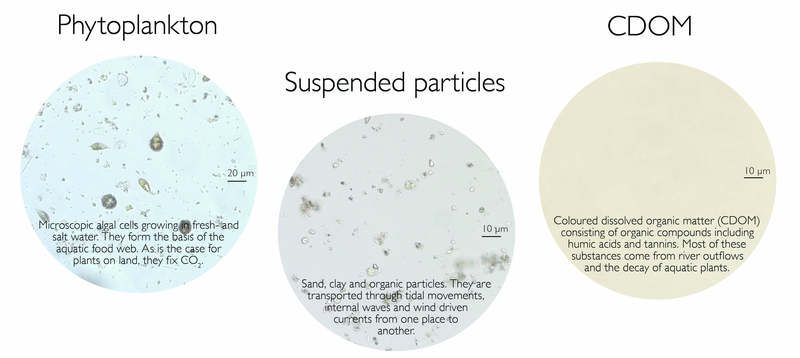Training materials
How to measure with light:
Light can be used to measure different materials in water. Results of such bio-optical measurements allow researchers to observe important indicators for climate change, or the consequences of excess nutrients in water over a long period of time.
The three most important substances to measure are:

Note the scale! 1mm = 1.000 µm, so these substances are really small. Images: Courtesy J. A. Busch
There are three simple means to measure these substances:
- Water colour
Sunlight consists of different colours. These are either absorbed or scattered by water. The red to green light is absorbed by water molecules, while blue light is strongly scattered. This is why water itself appears to be blue. The three substances affect the colour of water: phytoplankton leads to a green hue, while suspended particles lead to brown or red, and often give a cloudy effect to the water. Coloured dissolved organic matter give a yellow or brownish colouration. At the end of the 19th century, François-Alphonse Forel and Willi Ule introduced a method to classify the colour of natural water, using a colour comparator scale with 21 colours. Learn more about principles of water colour measurements here.
Details on how to use the Citclops App to measure water colour is listed here.
Water itself is blue. But sometimes it is green or brown. Why does water change its colour? And what can we learn from these changes? Discover the different colours of the sea with our colour wheel here. - Water transparency
Like on land, there is also a visibility range underwater. To measure it, the so called Secchi disk is used. This white disk is lowered vertically into the water. The depth at which it is no longer visible is defined as Secchi-depth. The Secchi-depth reduces as more substances occur in the water. In the open ocean this may be hundreds of meters, while in the coastal zone it can be as small as meters or centimetres. Learn more about principles of transparency here. - Water fluorescence
Sunlight consists of different colours that are scattered or absorbed from all - large and small - matter. Phytoplankton and organic matter re-emit a portion of the absorbed light in a different colour: in other words, they fluoresce. Learn more principles of fluorescence here.
Find out more interesting facts about measurements with light, or in other words, the use of optical sensors here.
